by Libbie Katsev, Yale University
Editor’s Note: Libbie Katsev, a Yale undergrad and writer for The New Journal, came to Common Ground while reporting an article on the groundswell of work to reclaim the West River Watershed. While on our campus, she met our West River Stewards Crew– Kathiana Torres, Gabe Rivera, Jalyn Johnson, and Science Teacher Dave Edgeworth — and offered to tell their story. This crew, part of Common Ground’s Green Jobs Corps, has taken on a variety of projects to research, restore, and build public awareness of the West River Watershed. Their work is supported by the Environmental Protection Agency Environmental Justice Small Grants Program, and the Woman’s Seamen’s Friends Society.
You can read Libbie’s full article on The New Journal Web site; read on to meet our West River Stewards!
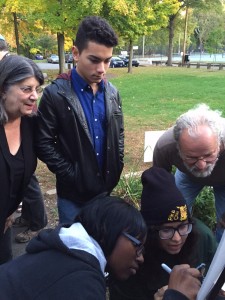
Gabe, Jalyn, and Kathiana – West River Stewards members — join other city residents in signing onto a new management plan for the West River.
When I arrive at Common Ground High School on an afternoon in early November, senior Kathiana Torres and two classmates have just gotten back from conducting a survey of Wintergreen Brook, which flows by Common Ground into the West River. The classroom door is open to the early night outside. Kathiana wears glasses, a Pokemon t-shirt, rubber boots, and waders—it’s the only way you can really be in the creek.
“If it’s really deep the waders start to press onto your skin but it’s really fun because it starts to feel really cool,” Torres says. A lover of animals, Kathiana likes being able to see Wintergreen’s amphibious and piscine inhabitants in their element. (She also shows me some that have been preserved in jam jars in one of the cupboards—pointing out some tiny crayfish and a turtle).
Now, having collected samples, the students are going through an ice tray, trying to tally up and classify the different insects they found on their excursion. A healthy insect population means a healthy brook. So far, the results are promising, but they haven’t gotten too far downstream yet. “What we’re hoping is that we’ll see it all the way down but I don’t think we’ll get it,” says Dave Edgeworth, the Common Ground science teacher who works with Kathiana and other members of Common Ground’s West River Stewards. While he says generally the West River is in decent condition, he added. “In several spots the habitat really is disturbed.”
Torres brings the tray up to the front, and Edgeworth peers into it through a magnifying glass. “That could be a baby stonefly,” he says.
“Yeah, that’s what we were thinking,” Torres responds. Later, she gets out a microscope in order to identify one of the bugs—to classify it, she needs to be able to see whether it has two or three tails. She lets me look through it first, and I stare down at a translucent creature with large eyes.
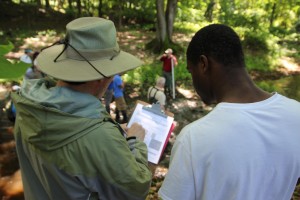
Science Teacher Dave Edgeworth and Tyreek, a member of the West River Stewards, join in a training on stream surveys. This past summer, the Stewards surveyed Wintergreen Brook from its headwaters to the confluence of with the West River.
Common Ground initially started doing work with the waterways a few years back, when some of the gates that prevented the tide from coming up were removed, making the West River a more natural environment. The tide gates had drastically changed the river since their installation in 1920, damaging the wetland environment.
Students started testing the water for salinity, temperature, and dissolved oxygen levels, to try to understand the changes that were happening with the incoming tide.
This summer, Torres worked cleaning up the watershed at Cherry Ann Park, West River Memorial Park, Beaver Ponds Park, and other locations: she cleared sites, removing invasive species and planting natives. (She even got poison ivy for the first time, after removing it from a tree.)
Common Ground students, both in summer and during the school year, have worked conducting water assessments. They’ve presented their data to the West River Watershed Coalition, the Environmental Protection Agency, and other groups: part of the task of cleaning up the river is just about surveying it. Now, they’re trying to figure out what their role will be as the restoration continues to move forward. Most of their thoughts so far include ways to increase access to the brook—which in many places can only be reached by waders—using trails, steps, footbridges. They’re also looking for ways to remove invasive species—including potentially feeding knotweed to the school goat–and cleaning up the trash along the water’s edge. The students list some of the garbage they’ve seen piled up: tires, beds, bicycles, balls, little kid’s toy cars—the kind that are big enough to ride in.
“If we clean it up the hardest part will be keeping it clean,” Torres says.

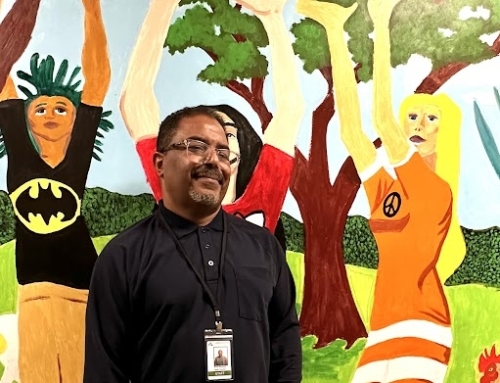

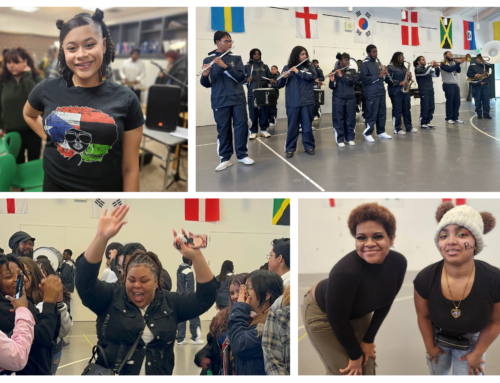
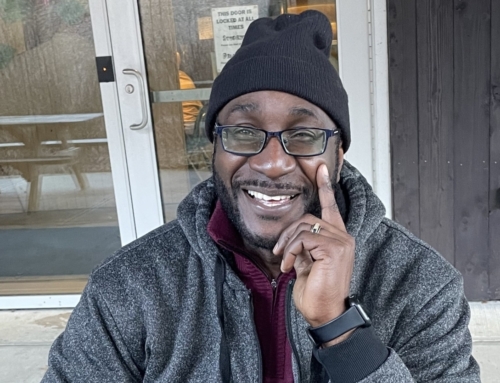
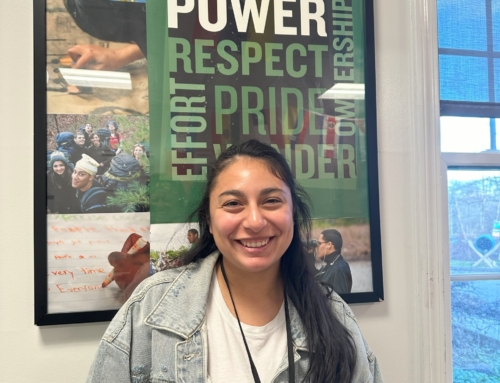
Leave A Comment